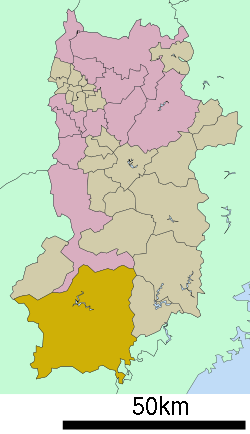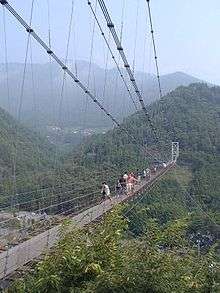Totsukawa
| Totsukawa 十津川村 | |||
|---|---|---|---|
| Village | |||
|
Top left:Jyuni(Twelve) Waterfall, Top upper right:View of Totsukawa Spa area, Top lower left:View of Kamiyu Spa area, Bottom left:Mount Shaka, Bottom right:Kazeya Dam | |||
| |||
 Location of Totsukawa in Nara Prefecture | |||
 Totsukawa Location in Japan | |||
| Coordinates: 33°59′N 135°48′E / 33.983°N 135.800°ECoordinates: 33°59′N 135°48′E / 33.983°N 135.800°E | |||
| Country | Japan | ||
| Region | Kansai | ||
| Prefecture | Nara Prefecture | ||
| District | Yoshino | ||
| Government | |||
| • Mayor | Yoshiki Saratani | ||
| Area | |||
| • Total | 672.35 km2 (259.60 sq mi) | ||
| Population (January 1, 2017) | |||
| • Total | 3,488 | ||
| • Density | 5.2/km2 (13/sq mi) | ||
| Symbols | |||
| • Tree | Cryptomeria | ||
| • Flower | Rhododendron | ||
| • Bird | Japanese bush warbler | ||
| Time zone | UTC+9 (JST) | ||
| City hall address |
225-1 Ōaza Ohara, Totsukawa-mura, Yoshino-gun, Nara-ken 637-1333 | ||
| Website |
www | ||
Totsukawa (十津川村 Totsukawa-mura) is a village located in Yoshino District, Nara Prefecture, Japan. It's recognized as the largest village in Japan in terms of land area.
As of January 2017, the village has an estimated population of 3,488[1] and a density of 5.2 persons per km2. The total area is 672.35 km2.
History
In 1889, a major flood happened in Totsukawa. The flood destroyed many homes and farms, so, many of Totsukawa’s people moved to Hokkaido (the northernmost tip of Japan). And they developed a new village there. It was named “Shintotsukawa”. “Shintotsukawa” means “New Totsukawa” in Japanese.
Climate
Totsukawa has a humid subtropical climate (Köppen climate classification Cfa), which is hot and humid in the summer (above 30 °C (86 °F)) and is somewhat cold in the winter with temperatures dropping to around freezing (0 °C (32 °F)).
| Climate data for Kazeya (Kazeya Totsukawa, elevation 301 m (988 ft)) | |||||||||||||
|---|---|---|---|---|---|---|---|---|---|---|---|---|---|
| Month | Jan | Feb | Mar | Apr | May | Jun | Jul | Aug | Sep | Oct | Nov | Dec | Year |
| Record high °C (°F) | 16.3 (61.3) |
20.9 (69.6) |
25.5 (77.9) |
31.6 (88.9) |
34.5 (94.1) |
35.8 (96.4) |
38.0 (100.4) |
39.4 (102.9) |
36.0 (96.8) |
30.4 (86.7) |
23.6 (74.5) |
21.7 (71.1) |
39.4 (102.9) |
| Average high °C (°F) | 7.7 (45.9) |
8.9 (48) |
12.7 (54.9) |
18.8 (65.8) |
23.1 (73.6) |
25.9 (78.6) |
29.7 (85.5) |
30.8 (87.4) |
27.0 (80.6) |
21.0 (69.8) |
15.5 (59.9) |
10.2 (50.4) |
19.3 (66.7) |
| Daily mean °C (°F) | 3.2 (37.8) |
3.8 (38.8) |
7.0 (44.6) |
12.3 (54.1) |
16.7 (62.1) |
20.3 (68.5) |
24.0 (75.2) |
24.6 (76.3) |
21.4 (70.5) |
15.6 (60.1) |
10.2 (50.4) |
5.3 (41.5) |
13.7 (56.7) |
| Average low °C (°F) | −0.4 (31.3) |
−0.2 (31.6) |
2.2 (36) |
6.8 (44.2) |
11.5 (52.7) |
16.1 (61) |
20.2 (68.4) |
20.7 (69.3) |
17.7 (63.9) |
11.6 (52.9) |
6.0 (42.8) |
1.3 (34.3) |
9.4 (48.9) |
| Record low °C (°F) | −6 (21) |
−7.2 (19) |
−4.4 (24.1) |
−1.9 (28.6) |
2.1 (35.8) |
8.2 (46.8) |
13.0 (55.4) |
13.8 (56.8) |
8.9 (48) |
1.6 (34.9) |
−1.6 (29.1) |
−4.8 (23.4) |
−7.2 (19) |
| Average precipitation mm (inches) | 78.6 (3.094) |
98.5 (3.878) |
166.2 (6.543) |
160.4 (6.315) |
219.1 (8.626) |
321.7 (12.665) |
356.8 (14.047) |
270.5 (10.65) |
282.7 (11.13) |
167.9 (6.61) |
111.1 (4.374) |
69.4 (2.732) |
2,314 (91.102) |
| Mean monthly sunshine hours | 96.2 | 98.0 | 122.8 | 145.1 | 142.0 | 108.1 | 130.6 | 147.9 | 112.9 | 114.6 | 109.6 | 105.6 | 1,429.5 |
| Source #1: Japan Meteorological Agency (1981 - 2010)[2] | |||||||||||||
| Source #2: Japan Meteorological Agency (1981 - 2010)[3] | |||||||||||||
Events
Main Events in Totsukawa
- January
- Totsukawa village Marathon Road Relay (From Uenoji to Shigesato)
- Subaru Marathon Race
- March
- Hatsu Uma Sai Festival at Tamaki Shrine
- May
- Shakunage (Rhododendron) Festival (in the 21st Century Forest)
- August
- Yuredaiko Drum Festival (August 4 around Tanize Suspension bridge)
- Bon-odori Dance Festival in Ohara・Musashi・Nishigawa. (They are designated as a significant intangible folk cultural asset.)
- Fureai Monogatari Dance Festival
- October
- Shuki Taisai (Autumn Festival) at Tamaki Shrine
- Taisai (Festival) at Kokuo Shrine
- Village Sports Festival
- November
- Totsukawa Village Cultural Festival
- December
- Mount Tamaki Joya Daiko. (Yunohara Lyceum from 11:30 p.m.) Only the first 108 visitors who visit the shrine on that day can hit the drum.
Landmarks

- The Tanize Suspension Bridge, one of Japan's longest steel-wire suspension bridges, is located in the Tanize/Uenoji area in northern Totsukawa 34°06′12″N 135°45′45″E / 34.10330°N 135.76251°E. It was built in 1954 and is 54 m high and 297 m long. Each family in the village donated 3,000 dollars to the construction. The money collected from the villagers totaled 80,000 dollars from people in region. It is a popular sightseeing spot now. Tourists can experience nature and thrills. Yuredaiko (the drums on the shaking bridge) is an event held on August 4 ever year. The team that performs on that day is called Kodama and they put on a powerful show of Japanese drums. Many people gather on that day to see the performance.
- There are gondolas called yaen in Totsukawa village. Yaen are small gondolas hung from ropes above a river and move from shore to shore of the river. A yaen is also called a “human powered ropeway” and is a peculiarity of Totsukawa. Yaen advance by pulling on a rope within the gondola. It takes about 10 minutes for the average person to cross a river. Since a person using a yaen has the appearance of a monkey on a vine, the name yaen was given. Though the existing yaen are mostly used by tourists now, yaen were used as a means of transportation in Totsukawa for a long time.
- Sasanotaki (Waterfall of the Bamboo Grass)34°03′43″N 135°51′23″E / 34.06192°N 135.85633°E This waterfall was put on the list of 100 best waterfalls in Japan. It is about 32 m tall. The trail head with access to the waterfall is located about 12 km from Takigawaguchi on the national route 168. Though Sasanotaki cannot be seen from the road, the trail head is well marked as a place for tourists by a large signboard. The waterfall is about a 10-minute walk from the trail head for the average visitor. After going through a set of stairs and a tunnel, the waterfall will appear before one's eyes in about three minutes. The water in the valley of Takigawa which comes from Sasanotaki is some of the cleanest water in Nara prefecture.
- Tamaki Shrine is a Shinto shrine located at the top of Mt. Tamaki (1,760m) in south-eastern Totsukawa 33°55′47″N 135°49′35″E / 33.92969°N 135.82650°E. It was built by the Emperor Sujin in 37 BC. and is surrounded by many big cedar trees. One of them is over 3,000 years old; it is called "Jindai Cedar Tree". Tamaki Shrine is registered with the UNESCO World Heritage Centre as part of the "Sacred Sites and Pilgrimage Routes in the Kii Mountain Range." See below:
- The village flower in Totsukawa is the alpine rose. 10,000 alpine roses have been gathered and placed in the 21st Century Forest from all over the world. Pink, white, light purple and red purple alpine roses are in full bloom in the forest. They serve coffee and handmade plum juice for free, and exhibit art crafts carved with chainsaws. Since this forest is deep in the mountains, and also the air is perfectly clear and the cherry trees around are beautiful, this area is said to be the best for bird-watching.
- Hatenashi mountain range is about 1200m in height. This mountain range is located on the boundary between Nara and Wakayama Prefecture and stretches about 30 km. The place where Hatenashi mountain range meets Kohechi at Kumano-Kodo route is called Hatenashi pass. This pass is 1070m high. The Kumano-Kodo pilgrimage routes are designated as a World Heritage Site. The reason why they were designated is because the Kumano-Kodo route has a cultural background which has been created through the relation between nature and people for years, and it has been passed down to present.
- Totsukawa is a resource rich village that consists of forest and water. Totsukawa is the largest village in Japan with an area of 67,235 ha. The forest area is 64,540 ha., which is 96% of the village’s area. Most of the trees were planted after World War II. Totsukawa’s forestry business once flourished, however, in recent years, it has been struggling. The problem is the depreciation of the price of wood, and also that the people are so old that they can not do forestry like their successors did. Few young people would like to continue the forestry business. People’s desire to do forestry is decreasing therefore many unwanted plants and trees are depriving the planted trees of nutrition due to the lack of weeding.
Fireflies
Fireflies live in Totsukawa especially in the beautiful valleys where water flows. Fireflies can be seen from the middle of June until the middle of July. In Nachiai you can see many fireflies. Only local people know about the fireflies in Nachiai. You can see fireflies on cool days but not on hot days. In Nachiai, you can see fireflies flying over the river and sitting on leaves.
UNESCO World Heritage
Two of the main hiking routes that lead through the mountains of Totsukawa are also registered as part of the "Sacred Sites and Pilgrimage Routes in the Kii Mountain Range" officially inscribed by the UNESCO World Heritage Centre in 2004.
Totsukawa Senior High School
Totsukawa Senior High School is in the south end of Totsukawa village. It is the oldest high school in Nara Prefecture. It was built by the order of Emperor Komei in 1864. This school is said to be the only high school in Japan built by the order of an emperor. Currently, there are only 152 students attending the school. The kendo (Japanese fencing) team and the rowing team go to Inter-high (national high school championships) every year. The kendo team has a long history and has produced many ranked kendo masters. Totsukawa Senior High School is far away from other towns; it is one of the most isolated high schools in Japan because of the mountains that surround the area.
Bunbukan
Totsukawa high school used to be called “Bunbukan” a long time ago. 'Bun' means to study and 'bu' means martial arts. Local samurais in Totsukawa village felt the need to study academics and learn martial arts so they asked the emperor to make a school in Totsukawa village. Bunbukan was started by Nakanuma Ryouzo in 1864. Nakanuma Ryouzo is a Confucian from Oki Island. Since Nakanuma Ryouzo is from Oki Island, Totsukawa high school students go to Oki Island for a school trip every year.
Busuke Ura invested great energy into Totsukawa education. He was born in a section of the village called Dedani on November 8, 1882. After graduating from Tokyo Kaisei Junior High School in 1902, he studied Chinese literature at Waseda University. After graduating from the university, he worked in education. Busuke became a teacher of Totsukawa Bunbukan in April 1914 and then he worked as the principal for 25 years. After retiring from Bunbukan he was asked to become the principal of Kaisei Junior High School where he had graduated. He died in 1959 at the age of 76. A statue was built by the students and village people in his honor.
Onsen - Hot Springs
Totsukawa has many natural onsen or hot springs. Tosenji hot spring in Totsukawa was put on the list of the best one hundred hot springs in Japan. The water from some of these hot springs is safe to drink. The source temperature of the water is about 70℃ and is also said to cure your cuts and burns. The hot springs in Totsukawa are unusual because the hot spring water is used, as is, directly from the source without reheating or recycling. Good onsen are said to keep you warm even long after bathing and many people claim this of the hot springs in Totsukawa. Compared to other hot springs in Japan, the hot springs in Totsukawa are less expensive to use. There are also many footbaths in Totsukawa which are said to have health benefits for feet. Footbaths in Totsukawa are free of charge.
Footbath
"Tosenji footbath" is located in the area of "Totsukawa-go" roadside station which stands in Totsukawa village of Nara.
Address:225-1 Ohara, Totsukawa village, Yoshino-gun, Nara Hot springs nutrients:sulfur spring (carbon dioxide-free, hydrogen sulfide-free) Temperature of hot spring water:60 °C Health benefits: neuralgia, hemorrhoid, and skin disease History:"Tosenji Spa" is a hot spring with the oldest history. "Subaru" Subaru is the biggest hotel in Totsukawa. There are three hot spring facilities at Subaru,and a footbath is one of them.
Hot spring nutrients : NaHCO3 Temperature of hot spring water : 70 °C Health benefits: cold constitution, neuralgic, affection of skin, arthralgic, diabetes, digestive disorder. "Iorinoyu" Iorinoyu is a new hot spring in Hiratani. The footbath is available free of charge.
Hot spring nutrients: NaHCO3 Temperature of hot spring water : 70 °C Health benefits : stiff shoulder, motor weakness, stiff joints, hemorrhoid, advance of health, burn, chronic skin disease.
Notable foods
Mukodamashi
Mukodamashi is one of the Japanese sweet dumplings and is also one of the popular foods in Totsukawa.
Story and origin
Mukodamashi is made from grass called foxtail millet. It is used especially for making rice cakes. People use mukodamashi instead of rice when a rice shortage happens. People in Totsukawa village started making it a long time ago. Its color is usually yellow, but Mukodamashi made in Totsukawa is white. The name of the rice cake “Mukodamashi” comes from an old story. A long time ago, rice was very precious and rice cakes were even more so. When they ran short of rice, house wives used “Mukodamashi” millet for making rice cakes instead of rice. Because this millet is so white, husbands in the village cannot tell the difference between them. “Damasu” means “deceive”, and “muko” means “husband.” So “Muko-damashi” means “deceive the husbands”. This is the reason people call this rice cake “Mukodamashi.” "Yubeshi" is one of the popular foods in Totsukawa village. To make Yubeshi, we first cut the top of a Yuzu mandarin. Then we take everything out and make it empty. Then, put miso or buckwheat powder into it. Put the lid back on the mandarin. Make a straw bag and put the Yuzu into it. We hang it under the roof and let it dry for about half a year. It is one of the traditional preserves in Totsukawa. It is very popular as souvenir. You can eat it with Japanese Sake, put it in Ocha-zuke, rice with Japanese tea, or put it in miso-soup.
"Roasted “ayu” with salt" is the staple dish of Totsukawa. This river fish is called ayu. “Ayu” is a kind of salmon. The habitat of this fish is west of Pacific ocean in places like East Asia and Japan. Even in English this fish is called “ayu”. Ayu fish can live only in clean rivers. In Totsukawa we can catch many of them in the summer season. They are delicate and it’s not so easy to keep them fresh. So when you want to eat them in the city area, you have to pay not little money for them.
Meharizushi
Meharizushi is a local specialty food of Totsukawa, Yoshino county and the surrounding areas. Meharizushi consists of a rice ball that has been wrapped in a pickled Takana leaf. The name comes from one having to open one's mouth and eyes wide in order to eat the food. The filling for meharizushi is different for each recipe, for instance sometimes pickles are put inside, sometimes soy sauce is added for taste and sometimes, there is no filling at all.
Public transportation
The only form of public transportation to/from Totsukawa village is a public bus system. The bus that runs to Totsukawa is the longest bus route in Japan. The bus line starts at Yamato-Yagi Station (Kashihara city, Nara prefecture) using the national roads 24 and 168, and finishes at JR Shingū Station in Shingu city, Wakayama prefecture. The road passes through many mountains and tunnels on the way through Totsukawa and the trip takes about 7 hours. A much needed break time on the way is included. They only run between 6-5pm at night
Sister cities
- Izumi, Kumamoto (now Yatsushiro)
- Higashiiyayama, Tokushima (now Miyoshi)
References
- ↑ "Official website of Totsukawa Village" (in Japanese). Japan: Totsukawa Village. Retrieved 24 April 2017.
- ↑ 風屋 年・月ごとの平年値 (in Japanese). Japan Meteorological Agency. Retrieved 4 April 2018.
- ↑ 風屋 観測史上1~10位の値 (in Japanese). Japan Meteorological Agency. Retrieved 4 April 2018.
External links

- Totsukawa Village web page (in Japanese)

